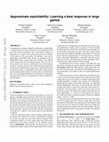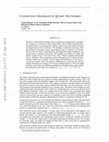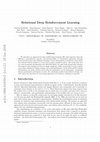Papers by Edward Lockhart
Science
We introduce DeepNash, an autonomous agent that plays the imperfect information game Stratego at ... more We introduce DeepNash, an autonomous agent that plays the imperfect information game Stratego at a human expert level. Stratego is one of the few iconic board games that artificial intelligence (AI) has not yet mastered. It is a game characterized by a twin challenge: It requires long-term strategic thinking as in chess, but it also requires dealing with imperfect information as in poker. The technique underpinning DeepNash uses a game-theoretic, model-free deep reinforcement learning method, without search, that learns to master Stratego through self-play from scratch. DeepNash beat existing state-of-the-art AI methods in Stratego and achieved a year-to-date (2022) and all-time top-three ranking on the Gravon games platform, competing with human expert players.

Cornell University - arXiv, Feb 23, 2018
Sequential models achieve state-of-the-art results in audio, visual and textual domains with resp... more Sequential models achieve state-of-the-art results in audio, visual and textual domains with respect to both estimating the data distribution and generating high-quality samples. Efficient sampling for this class of models has however remained an elusive problem. With a focus on text-to-speech synthesis, we describe a set of general techniques for reducing sampling time while maintaining high output quality. We first describe a single-layer recurrent neural network, the WaveRNN, with a dual softmax layer that matches the quality of the state-of-the-art WaveNet model. The compact form of the network makes it possible to generate 24 kHz 16-bit audio 4× faster than real time on a GPU. Second, we apply a weight pruning technique to reduce the number of weights in the WaveRNN. We find that, for a constant number of parameters, large sparse networks perform better than small dense networks and this relationship holds for sparsity levels beyond 96%. The small number of weights in a Sparse WaveRNN makes it possible to sample high-fidelity audio on a mobile CPU in real time. Finally, we propose a new generation scheme based on subscaling that folds a long sequence into a batch of shorter sequences and allows one to generate multiple samples at once. The Subscale WaveRNN produces 16 samples per step without loss of quality and offers an orthogonal method for increasing sampling efficiency. * Equal contribution 1 DeepMind 2 Google Brain.
Cornell University - arXiv, Nov 28, 2017
The recently-developed WaveNet architecture [27] is the current state of the art in realistic spe... more The recently-developed WaveNet architecture [27] is the current state of the art in realistic speech synthesis, consistently rated as more natural sounding for many different languages than any previous system. However, because WaveNet relies on sequential generation of one audio sample at a time, it is poorly suited to today's massively parallel computers, and therefore hard to deploy in a real-time production setting. This paper introduces Probability Density Distillation, a new method for training a parallel feed-forward network from a trained WaveNet with no significant difference in quality. The resulting system is capable of generating high-fidelity speech samples at more than 20 times faster than real-time, and is deployed online by Google Assistant, including serving multiple English and Japanese voices.

Proceedings of the Thirty-First International Joint Conference on Artificial Intelligence
Researchers have shown that neural networks are vulnerable to adversarial examples and subtle env... more Researchers have shown that neural networks are vulnerable to adversarial examples and subtle environment changes. The resulting errors can look like blunders to humans, eroding trust in these agents. In prior games research, agent evaluation often focused on the in-practice game outcomes. Such evaluation typically fails to evaluate robustness to worst-case outcomes. Computer poker research has examined how to assess such worst-case performance. Unfortunately, exact computation is infeasible with larger domains, and existing approximations are poker-specific. We introduce ISMCTS-BR, a scalable search-based deep reinforcement learning algorithm for learning a best response to an agent, approximating worst-case performance. We demonstrate the technique in several games against a variety of agents, including several AlphaZero-based agents. Supplementary material is available at https://arxiv.org/abs/2004.09677.

ArXiv, 2021
For artificially intelligent learning systems to have widespread applicability in real-world sett... more For artificially intelligent learning systems to have widespread applicability in real-world settings, it is important that they be able to operate decentrally. Unfortunately, decentralized control is difficult -- computing even an epsilon-optimal joint policy is a NEXP complete problem. Nevertheless, a recently rediscovered insight -- that a team of agents can coordinate via common knowledge -- has given rise to algorithms capable of finding optimal joint policies in small common-payoff games. The Bayesian action decoder (BAD) leverages this insight and deep reinforcement learning to scale to games as large as two-player Hanabi. However, the approximations it uses to do so prevent it from discovering optimal joint policies even in games small enough to brute force optimal solutions. This work proposes CAPI, a novel algorithm which, like BAD, combines common knowledge with deep reinforcement learning. However, unlike BAD, CAPI prioritizes the propensity to discover optimal joint pol...

ArXiv, 2019
Stochastic video prediction models take in a sequence of image frames, and generate a sequence of... more Stochastic video prediction models take in a sequence of image frames, and generate a sequence of consecutive future image frames. These models typically generate future frames in an autoregressive fashion, which is slow and requires the input and output frames to be consecutive. We introduce a model that overcomes these drawbacks by generating a latent representation from an arbitrary set of frames that can then be used to simultaneously and efficiently sample temporally consistent frames at arbitrary time-points. For example, our model can “jump” and directly sample frames at the end of the video, without sampling intermediate frames. Synthetic video evaluations confirm substantial gains in speed and functionality without loss in fidelity. We also apply our framework to a 3D scene reconstruction dataset. Here, our model is conditioned on camera location and can sample consistent sets of images for what an occluded region of a 3D scene might look like, even if there are multiple po...

Proceedings of the Twenty-Eighth International Joint Conference on Artificial Intelligence, 2019
In this paper, we present exploitability descent, a new algorithm to compute approximate equilibr... more In this paper, we present exploitability descent, a new algorithm to compute approximate equilibria in two-player zero-sum extensive-form games with imperfect information, by direct policy optimization against worst-case opponents. We prove that when following this optimization, the exploitability of a player's strategy converges asymptotically to zero, and hence when both players employ this optimization, the joint policies converge to a Nash equilibrium. Unlike fictitious play (XFP) and counterfactual regret minimization (CFR), our convergence result pertains to the policies being optimized rather than the average policies. Our experiments demonstrate convergence rates comparable to XFP and CFR in four benchmark games in the tabular case. Using function approximation, we find that our algorithm outperforms the tabular version in two of the games, which, to the best of our knowledge, is the first such result in imperfect information games among this class of algorithms.
ArXiv, 2020
We introduce a human-compatible reinforcement-learning approach to a cooperative game, making use... more We introduce a human-compatible reinforcement-learning approach to a cooperative game, making use of a third-party hand-coded human-compatible bot to generate initial training data and to perform initial evaluation. Our learning approach consists of imitation learning, search, and policy iteration. Our trained agents achieve a new state-of-the-art for bridge bidding in three settings: an agent playing in partnership with a copy of itself; an agent partnering a pre-existing bot; and an agent partnering a human player.

ArXiv, 2018
We introduce an approach for deep reinforcement learning (RL) that improves upon the efficiency, ... more We introduce an approach for deep reinforcement learning (RL) that improves upon the efficiency, generalization capacity, and interpretability of conventional approaches through structured perception and relational reasoning. It uses self-attention to iteratively reason about the relations between entities in a scene and to guide a model-free policy. Our results show that in a novel navigation and planning task called Box-World, our agent finds interpretable solutions that improve upon baselines in terms of sample complexity, ability to generalize to more complex scenes than experienced during training, and overall performance. In the StarCraft II Learning Environment, our agent achieves state-of-the-art performance on six mini-games -- surpassing human grandmaster performance on four. By considering architectural inductive biases, our work opens new directions for overcoming important, but stubborn, challenges in deep RL.

We introduce an approach for augmenting model-free deep reinforcement learning agents with a mech... more We introduce an approach for augmenting model-free deep reinforcement learning agents with a mechanism for relational reasoning over structured representations, which improves performance, learning efficiency, generalization, and interpretability. Our architecture encodes an image as a set of vectors, and applies an iterative message-passing procedure to discover and reason about relevant entities and relations in a scene. In six of seven StarCraft II Learning Environment mini-games, our agent achieved state-of-the-art performance, and surpassed human grandmasterlevel on four. In a novel navigation and planning task, our agent’s performance and learning efficiency far exceeded non-relational baselines, it was able to generalize to more complex scenes than it had experienced during training. Moreover, when we examined its learned internal representations, they reflected important structure about the problem and the agent’s intentions. The main contribution of this work is to introduc...
We introduce and analyze a class of algorithms, called Mirror Ascent against an Improved Opponent... more We introduce and analyze a class of algorithms, called Mirror Ascent against an Improved Opponent (MAIO), for computing Nash equilibria in two-player zero-sum games, both in normal form and in sequential form with imperfect information. These algorithms update the policy of each player with a mirror-ascent step to maximize the value of playing against an improved opponent. An improved opponent can be a best response, a greedy policy, a policy improved by policy gradient, or by any other reinforcement learning or search techniques. We establish a convergence result of the last iterate to the set of Nash equilibria and show that the speed of convergence depends on the amount of improvement offered by these improved policies. In addition, we show that under some condition, if we use a best response as improved policy, then an exponential convergence rate is achieved.
ArXiv, 2019
OpenSpiel is a collection of environments and algorithms for research in general reinforcement le... more OpenSpiel is a collection of environments and algorithms for research in general reinforcement learning and search/planning in games. OpenSpiel supports n-player (single- and multi- agent) zero-sum, cooperative and general-sum, one-shot and sequential, strictly turn-taking and simultaneous-move, perfect and imperfect information games, as well as traditional multiagent environments such as (partially- and fully- observable) grid worlds and social dilemmas. OpenSpiel also includes tools to analyze learning dynamics and other common evaluation metrics. This document serves both as an overview of the code base and an introduction to the terminology, core concepts, and algorithms across the fields of reinforcement learning, computational game theory, and search.

Nature, 2020
Constructing agents with planning capabilities has long been one of the main challenges in the pu... more Constructing agents with planning capabilities has long been one of the main challenges in the pursuit of artificial intelligence. Tree-based planning methods have enjoyed huge success in challenging domains, such as chess and Go, where a perfect simulator is available. However, in real-world problems the dynamics governing the environment are often complex and unknown. In this work we present the MuZero algorithm which, by combining a tree-based search with a learned model, achieves superhuman performance in a range of challenging and visually complex domains, without any knowledge of their underlying dynamics. MuZero learns a model that, when applied iteratively, predicts the quantities most directly relevant to planning: the reward, the action-selection policy, and the value function. When evaluated on 57 different Atari games-the canonical video game environment for testing AI techniques, in which model-based planning approaches have historically struggled-our new algorithm achieved a new state of the art. When evaluated on Go, chess and shogi, without any knowledge of the game rules, MuZero matched the superhuman performance of the AlphaZero algorithm that was supplied with the game rules.

Uploads
Papers by Edward Lockhart